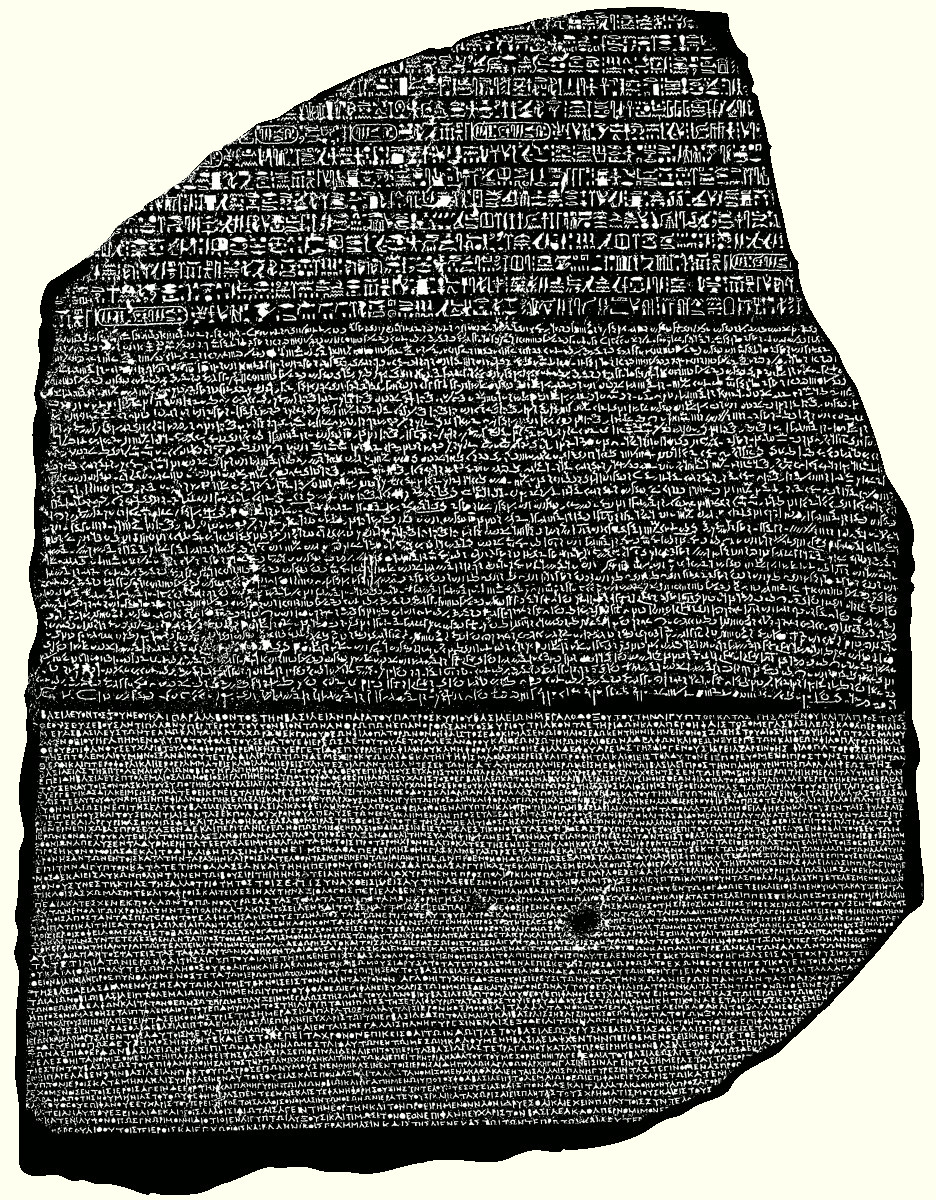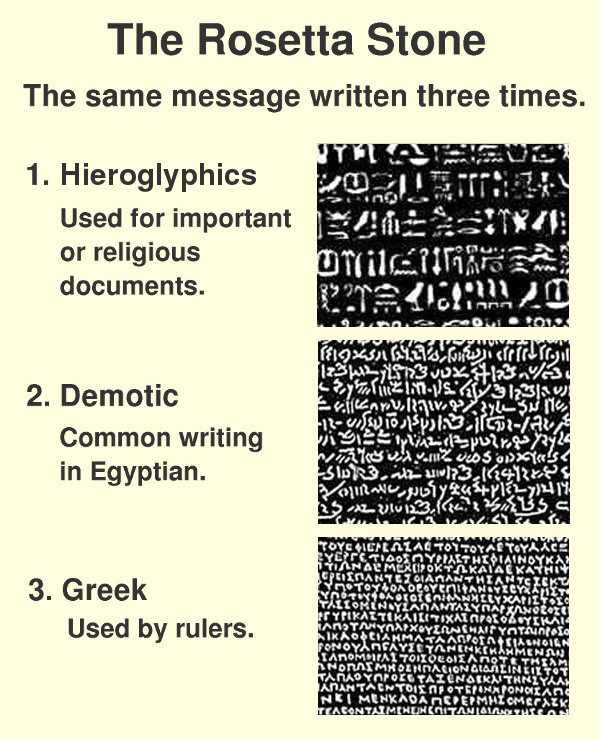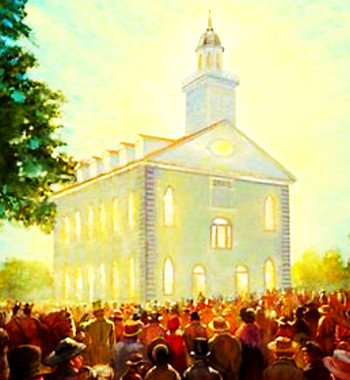
(Click to enlarge.)
by John P. Pratt
27 Feb 2021, Esther (PH), Eagle (S), Knowledge (US), 1 Gathered (P)
©2021 by John P. Pratt. All rights Reserved.
|
1. The Rosetta Stone 2. Two languages 3. Temple to be Built 4. Conclusion Notes |
 |
Consider what is to be learned from the Rosetta Stone.
The Rosetta Stone not only refers to an ancient stone on which the same declaration was written in different languages, that name is also used to denote any key to understanding some subject that might otherwise be inscrutable. The Sealed Book was translated into both English and Portuguese in parallel, so could it be that in some way this dual inspired translation might also provide some of the benefits offered the Rosetta stone?
That stone was discovered in 1799 while Napoleon was conquering Egypt. As shown in the illustrations, it has three kinds of writing on it. The middle language was Egyptian demotic, which was the common language of the people back around the time of the beginning of the Christian era and which was rather well understood by scholars of the day. The bottom language was written in well-understood Greek. It was thus easy to see that both of the bottom two inscriptions were making the same declarations about the accomplishments of the Pharaoh of that time.[2]
 |
Now consider how scholars try to determine the original meaning of a passage of scripture. They go back to the most original language they have. For example, consider different translations of the Bible into English. One of the first was done by John Wycliffe about 1350, translating from the Vulgate, being the Latin version produced by St. Jerome in the 4th Century. As time went on, it became clear that such was not the best idea because the Vulgate itself had been translated from the Hebrew and Greek versions. Two centuries later William Tyndale produced an English translation about 1530 from which much of the King James Bible was taken. He went back to the original languages of Hebrew for the Old Testament and Greek for the New Testament, as well as consulting the Latin Vulgate as a cross-check.[3] Thus, it was such a good idea to go back to original versions, as well to view another translation of those into Latin, that the King James Bible has remained a standard for centuries.
The point here is that in order to know the original meaning of any document, it makes sense to go back to the original language!
But there is a problem even with that method. Every language has weaknesses where it fails to distinguish between different related concepts. One language has two or three words for something where another has only one word. And that works both ways, where the second language has three or more words. English and Portuguese are two such languages.
Thus, the one possible reason that The Sealed Book was translated by the gift and power of God into two languages is that now a passage can be read in two different complementary languages, where each can be strong where the other is weak, thus giving more clarity to the intended meaning. That is, there are two "original" languages which can both be consulted.
 |
In English, there are two words "here" and "there" for distinguishing location. "Here" means close to the speaker and "there" is everywhere else. In Portuguese there are four such words: "aqui", "aí", "ali", and "lá". "Aqui" means close to the speaker, "aí" means close to the hearer, "ali" is not too far from both, and "lá" means far from both. In order to translate "aí" into English, one must say "there near you". At the present time the Google translator fails to do this, often translating "aí", "ali", and "lá" all as "there". Thus, information is lost in the translation.
Similarly, in English one can say, "He found her pen." The word "her" indicates the gender of the owner of the pen. It might have been "his", "her", or "its" pen. In Portuguese that sentence cannot be written so simply. The word in the place of "her" does not indicate the gender of the pen's owner, but rather the gender of all pens, which are feminine. That is, the word for pen, "caneta", is considered to be a feminine word, and that word indicating ownership must be feminine. A literal translation of the sentence could mean "He found [his, hers, or its] pen." If the sentence were written with four words in Portuguese, "Ele achou sua caneta", it would be understood to mean, "He found his pen." That is, of three possible meanings, it is implied that the owner of the pen must be the subject. In order to translate, "He found her pen", more words must be added to show the ownership: "Ele achou a caneta dela", which literally means "He found the pen of her."
These two examples show how each language may be more clear than the other when describing different topics, or at least may require fewer words to say the same thing. Writing the same idea in two different languages can clear up confusion in either one alone.
Consider one more example of a huge difference in meaning based on the simple words "this" and "that". There has been much confusion based on these two words alone in English, which are often used almost interchangeably, so imagine how they could be misunderstood in other languages. Moreover, the prophecy might also hinge on understanding the difference between the words "will" and "shall", which has almost been lost in the modern language. So please carefully consider the following.
Perhaps the most quoted prophecy of Joseph Smith which skeptics claim to have failed, and therefore making him a false prophet, is this one:
2 Yea, the word of the Lord concerning his church, established in the last days for the restoration of his people, as he has spoken by the mouth of his prophets, and for the gathering of his saints to stand upon Mount Zion, which shall be the city of New Jerusalem.
3 Which city shall be built, beginning at the temple lot, which is appointed by the finger of the Lord, in the western boundaries of the State of Missouri, and dedicated by the hand of Joseph Smith, Jun., and others with whom the Lord was well pleased.
4 Verily this is the word of the Lord, that the city New Jerusalem shall be built by the gathering of the saints, beginning at this place, even the place of the temple, which temple shall be reared in this generation.
5 For verily this generation shall not all pass away until an house shall be built unto the Lord, and a cloud shall rest upon it, which cloud shall be even the glory of the Lord, which shall fill the house. — D&C 84:2-5
What is your understanding of this prophecy? What does it say about when the temple in the New Jerusalem, in the western boundaries of Missouri, will be built. Was it predicted to be built in Joseph Smith's generation?
It turns out that the temple in Jackson County, Missouri, was never built. The LDS saints got the cornerstone laid but that was about all before being driven out of Missouri by angry mobs. They had time to do much more, but questioned the need, saying "What need is there for this temple?" (D&C 101:47).[4]
So what happened? Did this prophecy indeed fail? Is it not true that the Lord's promises will always be fulfilled (D&C 1:38)? Nearly every Mormon apologist defending this prophecy has claimed some very extended definition for the word "generation", which now requires that the generation last about two centuries!
 |
The reason why that possible explanation has not been published in my work is that the Lord's revelations to Joseph Smith tended to be in Joseph's language as he understood it, so the Lord may not have depended on that technicality being known. Moreover, the Lord's usage of the words "will" and "shall" does not seem consistent, even within that same revelation, so that explanation was not compelling and does not appear to be correct.
Another proposed interpretation, however, is more satisfying, and also is based on the meanings of two very simple words, "this" and "that", which have the same meanings today as in the time of the Prophet Joseph. When using those words as an adjective, such as "this place", it refers to something near the speaker, whereas, "that place" is somewhere else. That is very much like the words "here" and "there" as discussed above.
If the Lord was indeed using those words in the traditional sense, then it is necessary to know were the revelation was given, because verse 4 refers to the temple lot at "this place." It turns out the revelation was given in September 1832 in Kirtland, Ohio, after the saints had begun to gather there since early 1831.
Reading the same prophecy with that understanding, yields the following, with my interpretation in square brackets []:
2 Yea, the word of the Lord concerning his church, established in the last days for the restoration of his people, as he has spoken by the mouth of his prophets, and for the gathering of his saints to stand upon Mount Zion, which shall be the city of New Jerusalem.
3 Which city shall [command?] be built, beginning at the temple lot [which site had already been dedicated there 3 Aug 1831], which is appointed by the finger of the Lord, in the western boundaries of the State of Missouri, and dedicated by the hand of Joseph Smith, Jun., and others with whom the Lord was well pleased.
4 Verily this is the word of the Lord, that the city New Jerusalem shall be built by the gathering of the saints, beginning at this place [which gathering is commencing here in Kirtland], even the place of the temple, which temple shall [command?] be reared in this generation [the first LDS temple was indeed built in Kirtland!].
5 For verily this generation shall not all pass away until an house shall [command?] be built unto the Lord, and a cloud shall [prediction?] rest upon it, which cloud shall [prediction?] be even the glory of the Lord [a cloud of light, appearing like tongues of fire indeed appeared at the dedication of the Kirtland temple], which shall [prediction?] fill the house [angels and glory were also seen with the temple at the dedication]. — D&C 84:2-5
Thus, not confusing the meanings of the simple words "this" and "that", shows that the prophecy of a temple being reared at "this place" and being filled with the Lord's glory was indeed fulfilled!
The question is addressed as to why the Lord would require the Brazilian seer Mauricio Berger to translate the first part of the formerly sealed portion of the Plates of Mormon into both Portuguese and English in parallel, especially considering that he does not speak English.
A comparison was made to the Rosetta Stone, which has the same declaration written three times, which allowed deciphering of Egyptian hieroglyphics. Having the new scriptures of The Sealed Book in two "original" languages gives added clarification because English and Portuguese have complementary strengths to compensate for weaknesses in each language.
Finally, an example of a revelation given to the Prophet Joseph Smith which apparently has been misunderstood by simply confusing the meanings of the word "this" for "that", resulting in many critics having claimed that Joseph must have been a false prophet because the revelation was not fulfilled according to their apparently incorrect understanding.
Thus, it is concluded that a likely reason that that The Sealed Book was translated into two languages simultaneously, even though that required two scribes and more time, was to give us two "original" sources in two different complementary languages. All of this attests to the wisdom and glory of God!